
Light and neutron scattering
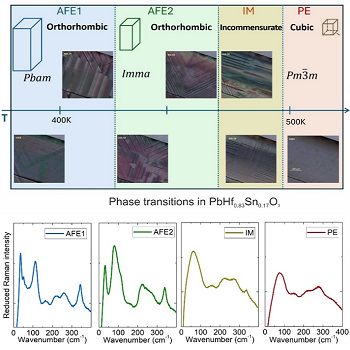
Phonon studies of the phase transition sequence in an antiferroelectric single crystal
The sequence of phase transitions in PbHf0.83Sn0.17O3 was studied using THz, far-infrared, and Raman spectroscopies.
These investigations revealed the complementary roles of polar and non-polar phonons in lattice dynamics,
establishing the sequence of transitions on cooling as PE → IM → AFE2 → AFE1
[J. Appl. Phys. 138, 104101 (2025)].
The investigation of Pb(Hf,Sn)O3 and the fundamental mechanism of its antiferroelectric properties help to advance in the field of materials for energy storage. This paper aims to better understand the lattice dynamics and the different phonons that drive the exotic phase transitions of this system, including an unknown intermediate phase at high temperatures.
The sequence of phase transitions in PbHf0.83Sn0.17O3 (PHS-17) has been studied by THz, far infrared, and Raman spectroscopies. Spectroscopic investigations revealed the complementary behaviour of both polar and non-polar phonons and their impact on the lattice dynamics, concluding that the sequence of phase transitions for PHS-17 on cooling is PE → IM → AFE2 → AFE1.
Symmetry analysis and optical observations revealed that the intermediate IM phase has plausible tetragonal symmetry and it is, driven by an polar instability from the center of the Brillouin zone. Domain dynamics suggests that the presence of Sn triggers the development of the IM phase with its distinctive tweed pattern. The overall transformation from the cubic paraelectric phase (PE) to the final antiferroelectric orthorhombic Pbam phase (AFE1) thus involves two middle phases that sequentially accommodate the shifts of Pb atoms and tilts of the oxygen octahedra. The Pb atom is more sensitive to the high temperature phase transitions through strong dielectric anomalies, while oxygen atoms are more significant in the AFE2 and AFE1 phases, where their antiferrodistortive modes become the main driving force.
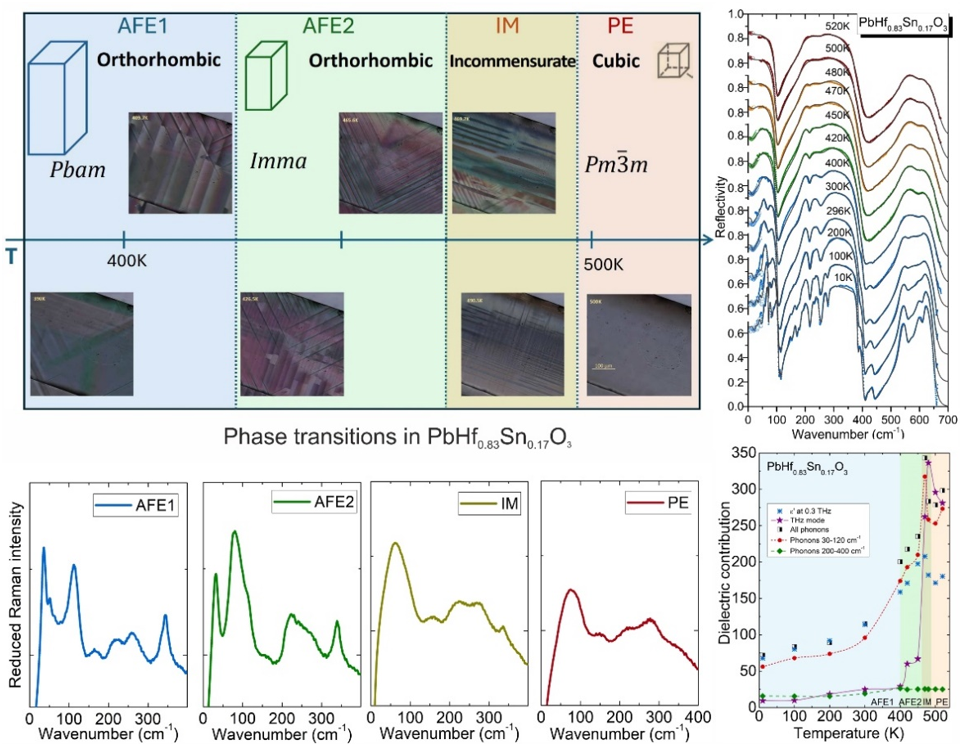
Schematics of the phase transition sequence in antiferroelectric Pb(Hf0.83Sn0.17)O3.
[1] Anirudh K R, C. Milesi-Brault, C. Kadlec, D. Nuzhnyy, A. Majchrowski, M. Krupska-Klimczak, I. Jankowska-Sumara, and E. Buixaderas,
Phonon studies of the phase transition sequence in antiferroelectric single crystal of Pb(Hf0.83Sn0.17)O3,
J. Appl. Phys. 138, 104101 (2025).
(show less)
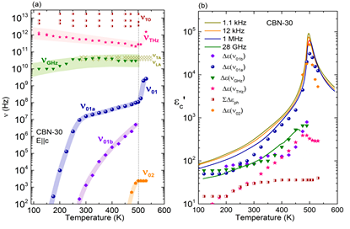
Coexisting polarization mechanisms in tetragonal tungsten bronze Ca0.3Ba0.7Nb2O6
We have proven that Ca0.3Ba0.7Nb2O6 displays a ferroelectric phase transition of mixed displacive and order-disorder character, and that its paraelectric phase does not show traces of relaxor behaviour but precursor effects as polar fluctuations below about 550 K [Phys. Rev. B 110, 104302 (2024)].
Tetragonal tungsten bronzes are the second most important ferroelectric family after the perovskite one, and they give more versatility to play with multiferroic properties, as it has 5 different crystallographic sites to fill with different elements (see Figure 1). In this work we have used a broad band dielectric spectroscopy approach to study the dielectric response of one of these interesting compounds Ca0.3Ba0.7Nb2O6 (CBN3-30) within an impressive frequency range of 14 decades: from 1 Hz to 1014 Hz. We have proven that CBN-30 displays a ferroelectric phase transition of mixed displacive and order-disorder character, and that its paraelectric phase does not show traces of relaxor behaviour but precursor effects as polar fluctuations below about 550 K. This is partially attributed to the presence of Ca in the lattice, and its effect on maintaining the long-range polarization due to the Nb displacements along the main axis and suppressing the perpendicular displacements.
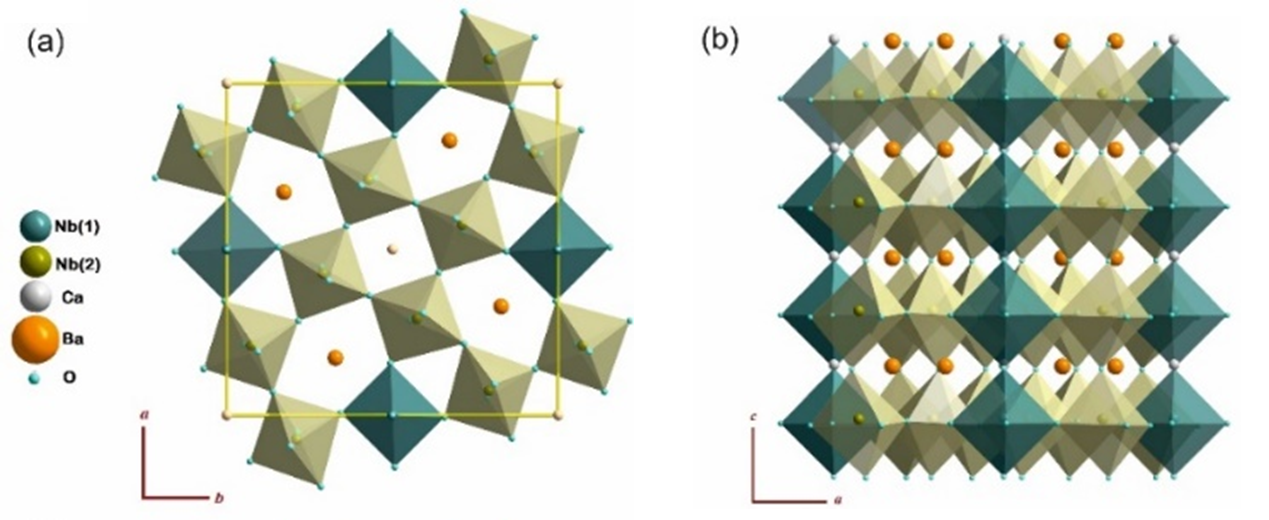
Figure 1: Structure of CBN-30 in two orientations. Nb(1) are inside the linking octahedra in dark colour, and Nb(2) inside the perovskite-like octahedra in light colour.
The analysis of the sub-MHz dielectric response together with infrared and Raman spectroscopy reveals that simultaneous polarization mechanisms are responsible for the phase transition. The main excitations have been phenomenologically assigned to phonons, to a soft anharmonic vibration of cationic origin, and to a relaxation in the GHz range related to polarization fluctuations of nanometric size. This GHz relaxation carries the main part of the permittivity at high temperatures in the paraelectric phase and on cooling it splits below TC into several weaker excitations with different polarization correlation lengths. The comparison of the excitations found in CBN-30 with those of the famous (Sr,Ba)Nb2O6 reveals that these mechanisms are congruous, although in CBN-30 the main relaxation process behaves differently due to the different domain structure and the presence of more distorted oxygen octahedra network. The overall dielectric response was therefore explained by coexistence of several excitations with different thermal behaviors, corroborating the complexity of the tetragonal tungsten bronze structures.
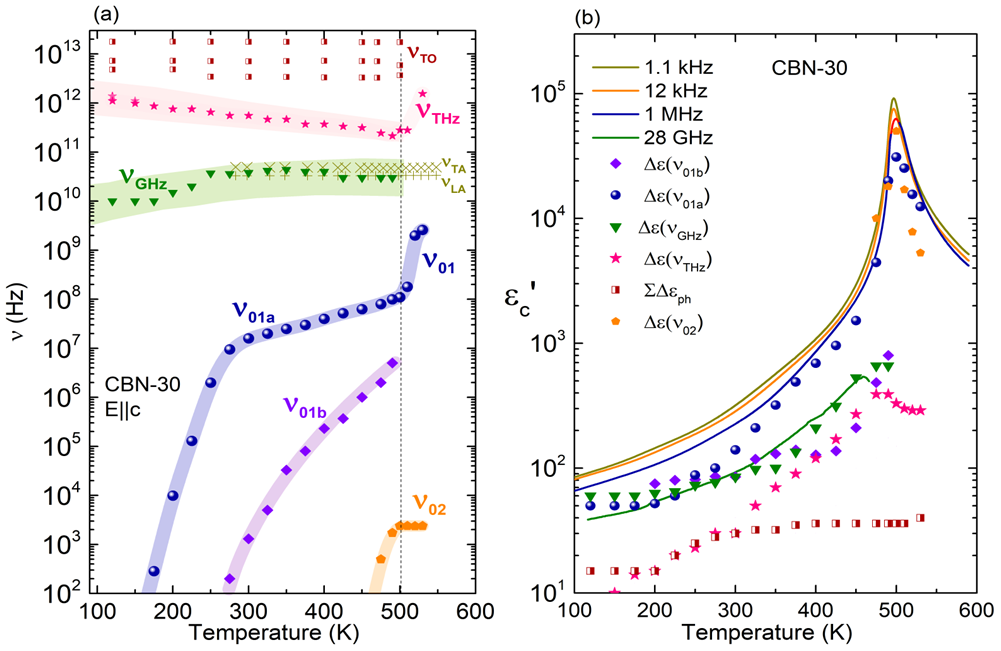
Figure 2: Temperature dependence of the frequencies of the main excitations in CBN-30 (a), and their dielectric contribution to the permittivity (b), together with selected experimental data.
This work was partially supported by the Czech Academy of Sciences and the Lithuanian Academy of Sciences through the bilateral Project No. LAS-21–02. E.B. acknowledges support from the Ministry of Education, Youth, and Sports of the Czech Republic by the EU cofunded grant “Ferroic Multifunctionalities”, Project No. CZ.02.01.01/00/22_008/0004591.
Reference
[1] E. Buixaderas, Š. Svirskas, C. Kadlec, M. Savinov, P. Lapienytė, Anirudh K.R., C. Milesi-Brault, D. Nuzhnyy, and J. Dec Coexisting polarization mechanisms in ferroelectric uniaxial tetragonal tungsten bronze Ca0.3Ba0.7Nb2O6 (CBN-30) Phys. Rev. B 110, 104302 (2024).
(show less)
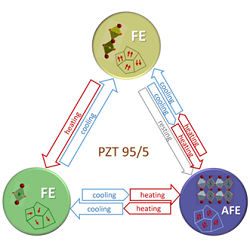
Paving the way to a 3-state thermal switch using antiferroelectric Pb(Zr1-xTix)O3
We propose a novel approach of phase-control in Pb(Zr0.95Ti0.05)O3 (PZT95/5) based on the thermal behavior of its phases. Our results show the possibility to thermally switch among three states near room temperature using small temperature gradients by heating-cooling cycles at slow rates. Thus, PZT95/5 ceramics are potential materials for room temperature device applications [Acta Materialia, 119208 (2023), online].
Pb(Zr1-xTix)O3 with very high content of Zr shows an antiferroelectric ground state and possesses an exceptional property: the coexistence of several built-in structural instabilities at high temperatures. This leads to the possibility of their successive condensation on cooling to trigger a sequence of phase transitions, instead of reaching directly the antiferroelectric state, as in pure PbZrO3. This peculiar behaviour is more pronounced in compositions near the antiferroelectric morphotropic phase boundary and the tricritical point around room temperature, as Pb(Zr0.95Ti0.05)O3 (PZT 95/5), where three phases are energetically available.
Raman scattering experiments performed out of the thermodynamical equilibrium revealed a complex and hysteretic thermal behaviour of the phase transition dynamics, due to the inhomogeneous microstructure and the coexistence of regions with different phases within the samples. A way to control the thermal development of these different phases is to selectively condense the different instabilities by an external parameter such as temperature, hence creating a sequence of phase transitions instead of a direct phase transition.
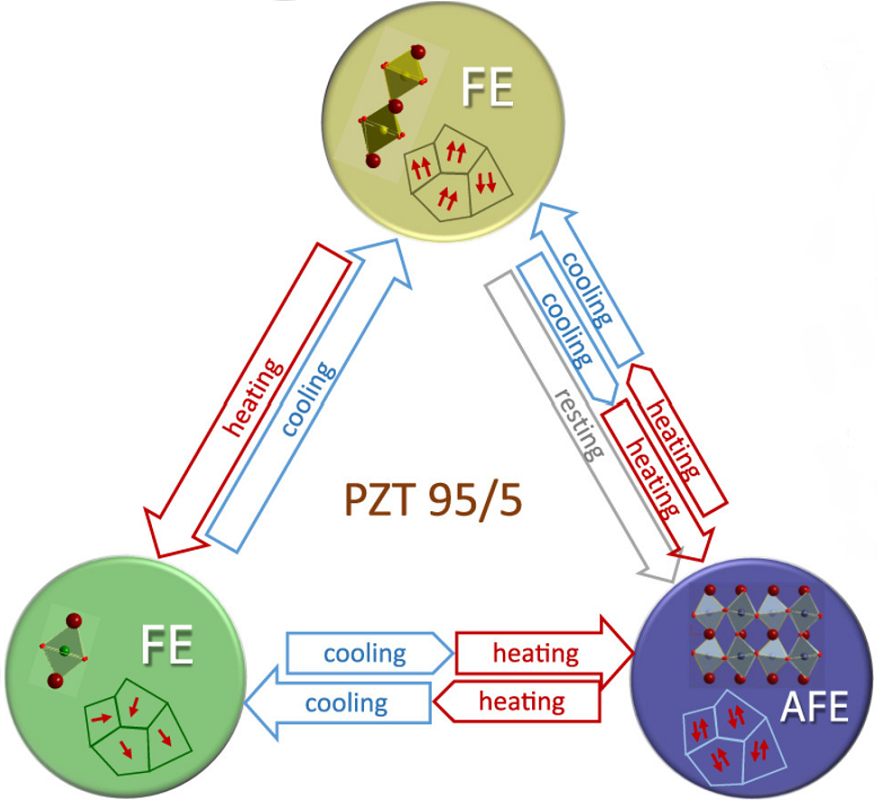
Figure: Scheme of thermal switching using the three near-room-temperature phases of PZT 95/5.
Our results, obtained under many different experimental conditions and specific pre-history, suggest that ceramics with composition near PZT 95/5 are potential materials for novel 3-state thermal switches. An innovative approach of phase-control is proposed, based on the thermal behaviour of the intermediate polar states observed and using small temperature gradients by appropriate heating-cooling cycles around room temperature.
Reference:
[1] E. Buixaderas, C. Milesi-Brault, P. Vaněk, J. Kroupa, F. Craciun, F. Cordero, C. Galassi,
Peculiar Dynamics of Polar States at the Morphotropic Phase Boundary of Antiferroelectric Pb(Zr1-xTix)O3,
Acta Materialia, 119208 (2023), online.
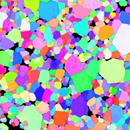
Raman scattering yields cubic crystal grain orientation
The anisotropy of Raman scattering was applied to determine the orientation of individual microcrystal grains, as small as a few µm, of GaV4S8 polycrystalline compound. This was possible by measuring polarised Raman spectra as a function of rotation of the sample along the laser direction. On comparing the resulting set of spectra with a computer simulation for particular symmetries, the orientation of the crystal grains could of the determined with good precision.
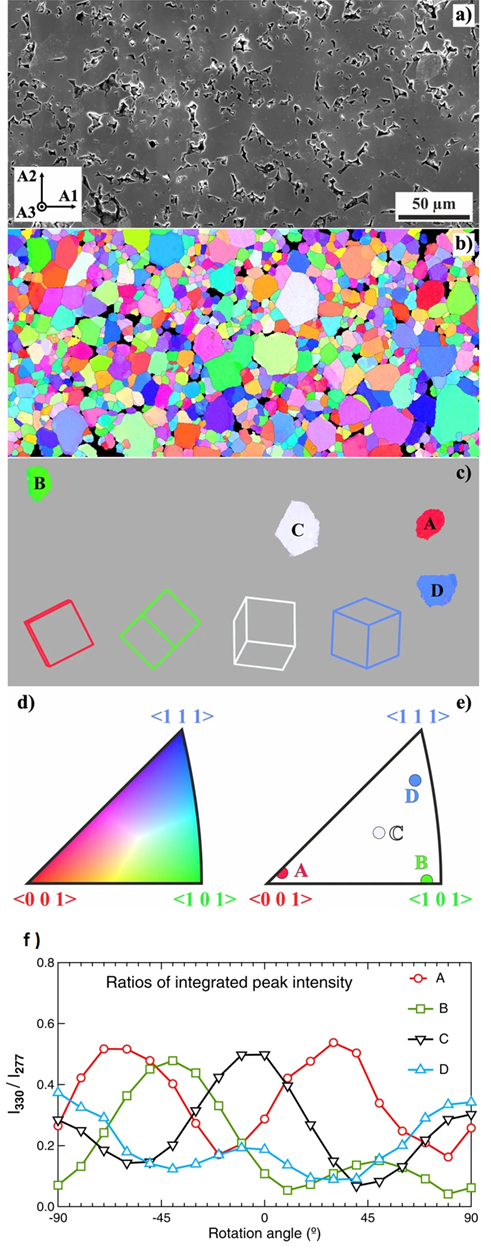
Figure:
Grain morphology of the investigated GaV4S8 ceramics.
(a) Scanning electron microscope image of an area of interest with sample coordinate system as an inset;
(b) Inverse pole figure map from EBSD analysis of the area in (a);
(c) positions of four grains chosen for detailed Raman measurements,
indicated projections of elementary cubic cells clarify their crystallographic orientation;
(d) unit triangle with the colour code of the inverse pole figure map;
(e) surface normals of the chosen grains;
(f) Parallel-polarised Raman scattering intensity ratios detected from the four grains,
which allows determination of their crystallographic orientation independent of the EBSD analysis.
Data shows intensity ratio at selected frequencies as a function of the angle ϕ
between the polariser and the reference direction on the sample surface.
K. Tesar, I. Gregora, P. Beresova, P. Vanek, P. Ondrejkovic, and J. Hlinka, Raman scattering yields cubic crystal grain orientation, Scientific Reports 9, 9385 (2019).
(show less)
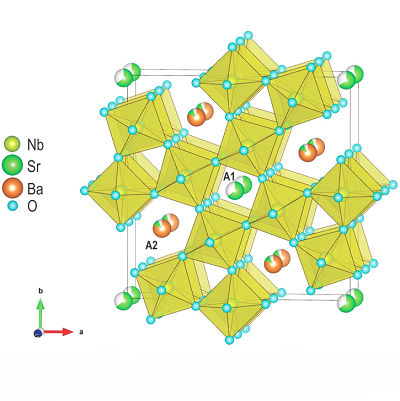
The ferroelectric phase transition of the tetragonal tungsten-bronze SBN-35 unveiled
The structural ferroelectric-paraelectric transition has been definitely observed by electron diffraction tomography in the tetragonal tungsten-bronze (TTB) Sr0.35Ba0.61Nb2O6.04 (SBN-35) from the paraelectric group P4/mbm to the ferroelectric Pmbm. At 625 K, the refined structure shows that the average structure of SBN-35 is tetragonal with an almost negligible orthorhombic distortion [Fig.1].
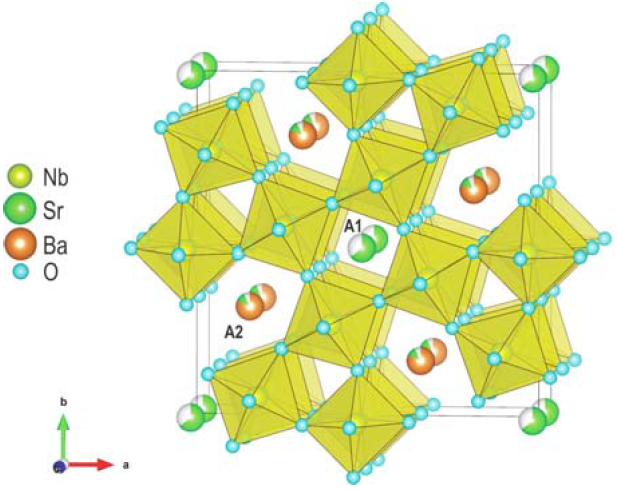
The combination of structural and broad-band dielectric studies in SBN-35 suggests that ferroelectricity in TTBs in caused by a more complex mechanism than in perovskites. Several excitations were identified related to the multiple mechanisms responsible for the ferroelectric phase transition [Fig.2]:
- Phonons, related to cation displacements along the polar axis,
- An anharmonic excitation located in the THz range (the CM νTHz), caused by the dynamic disorder of Sr and Ba atoms located at the A2 sites in the pentagonal channels, as supported by the high anisotropic displacements found in the electron diffraction experiment.
- A relaxation in the GHz range, ν01, which slows down to several MHz on cooling and related probably to Nb atoms dynamics.
- A relaxation which appears in the spectra below TC near 1 GHz and hardens on cooling, consistent with the oscillations of the ferroelectric domain walls.
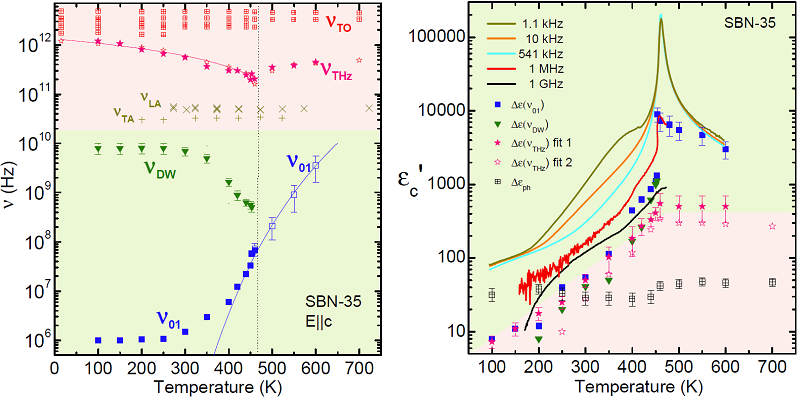
Fig. 2: Temperature dependences of the frequencies of the different excitations found in SBN-35 and their dielectric contributions.
[1] E. Buixaderas, M. Kempa, V. Bovtun, C. Kadlec, M. Savinov, F. Borodavka, P. Vaněk, G. Steciuk, L. Palatinus, and J. Dec, Multiple polarization mechanisms across the ferroelectric phase transition of the tetragonal tungsten-bronze Sr0.35Ba0.61Nb2O6.04 , Phys. Rev. Materials 2, 124402 (2018).
(show less)
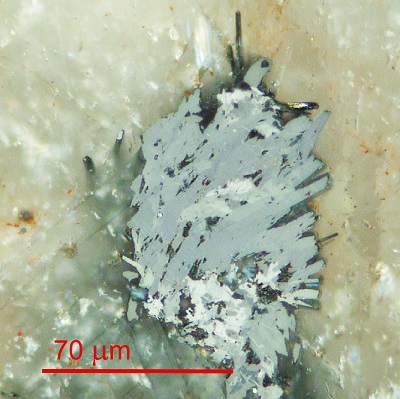
Přibramite, a new Se-containing mineral from the Czech Republic, characterized by Raman spectroscopy
Minerals containing selenium are interesting and worthy to study due to its inherent photovoltaic effect. The characterization and understanding of these natural minerals is important to be able to make synthetic analogues.
In the paper by Sejkora et al [1] several members of the CuSbS2-CuSbSe2 join were studied by micro–Raman spectroscopy:
- příbramite CuSbSe2, which got its name from its bith place, Příbram (Czech Republic)
- chalcostibite CuSbS2 from Dúbrava (Slovak Republic)
- Se-rich chalcostibite
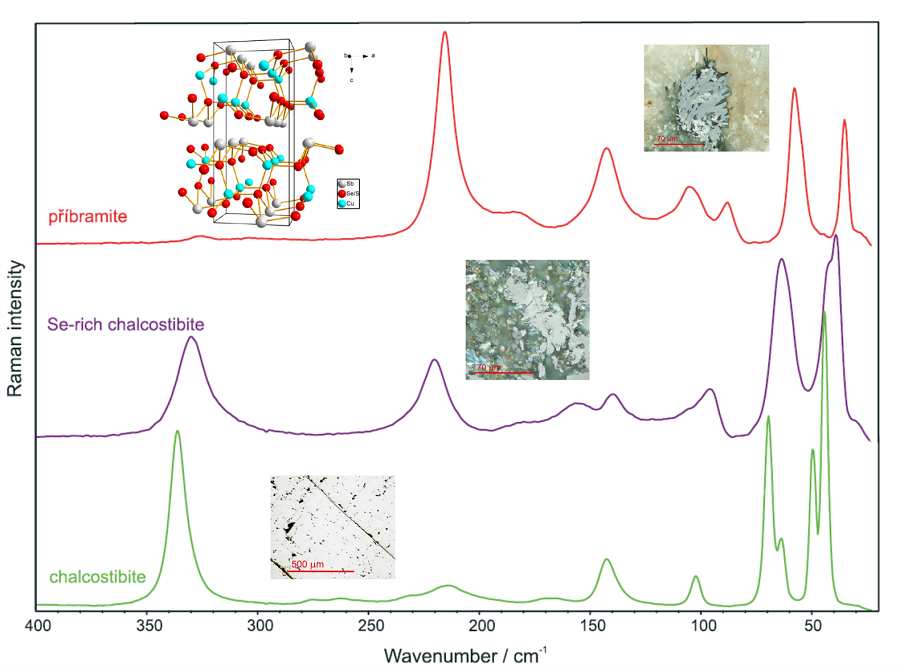
Figure: Raman spectra of the three mineral members along the CuSbS2-CuSbSe2 join, together with their micrographs and the depicted structure for příbramite.
[1] Jiří Sejkora, Elena Buixaderas, Pavel Škácha, Jakub Plášil, Micro-Raman spectroscopy of natural members along CuSbS2-CuSbSe2 join , J. Raman Spectroscopy 49, 1364 (2018).
(show less)
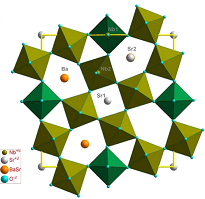
Fast polarization mechanisms in uniaxial tungsten-bronze SBN-81
The high-frequency dielectric response of the uniaxial strontium barium niobate (SrxBa1−xNb2O6) crystals with 81% of Sr (x = 0.81) was studied from 1 kHz to 30 THz along the polar axis in a wide temperature interval [E. Buixaderas et al, Sci. Rep. 7, 18034 (2017)]. Relaxor properties were observed in the complex dielectric response and four main excitations were ascertained below the phonon frequencies. These fast polarization mechanisms take place at THz, GHz and MHz ranges and show different temperature evolution.
A central mode excitation in the THz range, due to anharmonic dynamics of cations, shows critical behaviour
towards T~400 K. At lower frequencies, around 10 GHz, another excitation (νDW) appears below Tm~330K,
which is related to the development of ferroelectric microdomains.
In addition, several relaxations below the phonon frequencies, play an essential role in the dielectric
response of the crystal. The main contribution to the permittivity comes from a strong relaxation (ν01) present
in the GHz range at high temperatures which slows down on cooling following the Arrhenius law.
A second relaxation with lower frequency (ν02) slows down, as well, contributing to
the permittivity mainly near Tm.
Both these relaxations can be assigned to polar fluctuations, probably flipping and breathing of polar nanodomains.
Altogether, the four mechanisms explain, above the kHz range, the ferroelectric transition in SBN-81 as well as
its relaxor character, which differs from the behaviour displayed by SBN-61 and lead-based relaxors.
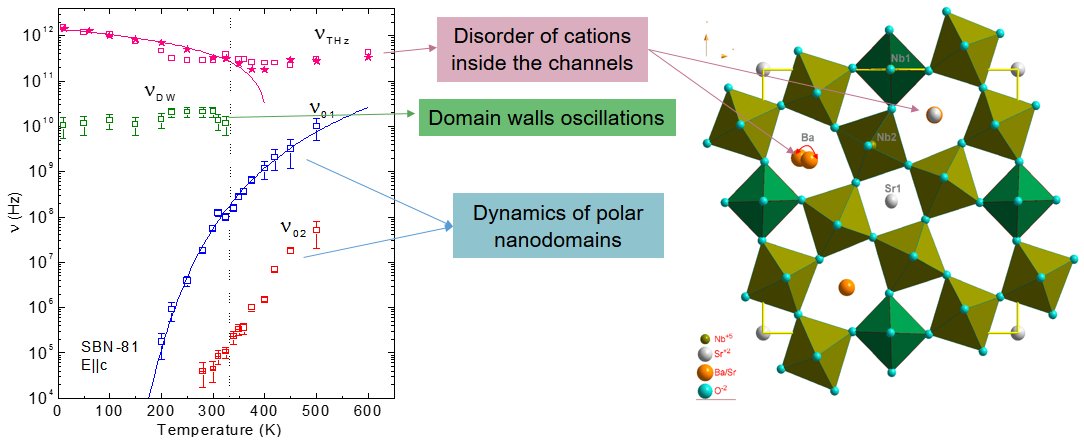
Figure: Temperature dependences of the frequencies of main excitations in the tetragonal tungsten-bronze structure SBN-81, related to the microstructure of the crystal.

Macroscopic heterophase pattern in Pb(Mg1/3Nb2/3)O3-PbTiO3 crystals
Polarization dependence of the Raman scattering intensities demonstrate that lamellar structures observed in (1 - x)Pb(Mg1/3Nb2/3)O3-xPbTiO3 (PMN-xPT) single crystals are composed of tetragonal-like and rhombohedral-like layers extending over macroscopic (mm) lengths.
Lamellar heterostructures, observed in PMN-0.32PT single crystals are formed in samples cooled under bias electric field applied along [001]pc and then zero-field heated to the vicinity of the so-called depoling temperature TRT. Similar structures were also encountered at ambient conditions. Spatially resolved polarized Raman scattering techniques confirmed that the stripe pattern is due to the coexistence of the phases attached to the opposite sides of the morphotropic phase boundary in the temperature-composition phase diagram [ I. Rafalovskyi et al., Phys. Rev. B 93, 064110 (2016) ].
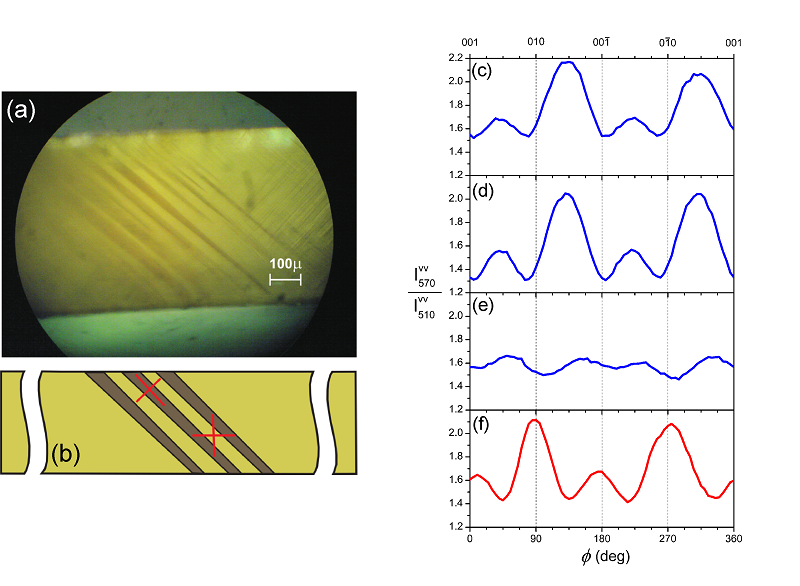
Figure: a) Optical micrograph in a reflection mode, and (b) schematic illustration. Red crosses indicate orientation of polarizers on incident and scattered beam in configurations with a minimum Raman intensity at 570 cm−1. Right panel shows angular dependence of the I570/I510 intensity ratio for the parallel-polarized Raman scattering intensities, evaluated from the measurements taken at ambient conditions. Panels allow us to compare (c) data taken in the dark stripe, (d) data taken in a single-domain ([111]pc-poled) sample, (e) data taken in a multidomain, frustratively poled ([100]pc-poled) sample, and (f) data taken in the light stripe. The scattering geometry with respect to the pseudocubic crystallographic axes is common to all four cases displayed.
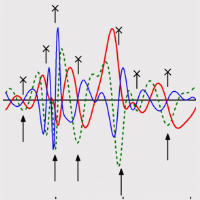
Compositional behaviour of phonons in Pb(Zr1-xTix)O3 ceramics
Raman spectra of PZT ceramics were studied systematically in a broad temperature interval (10–600 K) and a broad Ti/Zr concentration range around the morphotropic phase boundary (x = 0.25–0.70) [ E. Buixaderas et al., Phys. Rev. B 91, 014104 (2015) ].
We developed a purposely designed mathematical analysis of the Raman spectra based on their frequency derivatives: the method finds the curvature maxima in concave-down regions of the spectra (CMCD analysis), in order to count peaks and shoulders of the experimental spectra, comparing them to the results of the standard fitting with damped harmonic oscillators. The combination of the two approaches is very helpful to find “hidden” structure in the spectra of disordered materials.
In the case of PZT, the crossover from the tetragonal to the rhombohedral phase is clearly visible in the Raman spectra; however, there are no indications of a systematic splitting of the E-symmetry modes into A’–A’’ doublets related to the monoclinic symmetry in the morphotropic samples. Detailed adjustment of the response function to the spectrum requires to assume additional Raman active modes, but this holds for a much broader concentration range than that of the anticipated monoclinic phase.
The analysis of the phonons found also that the lowest frequency transverse optic mode of E-symmetry (soft mode of the ferroelectric phase transition) is split into two components, a THz frequency anharmonic (central mode-like) component and a resonant component (at frequencies ω ~ 80 cm-1). A new Raman band appearing in this frequency range at low temperatures is rather associated with the anti-phase tilt vibrations of the oxygen octahedra. These results are in perfect agreement with our previous IR studies on these ceramics [ E. Buixaderas et al., Phys. Rev. B 84, 184302 (2011) ].
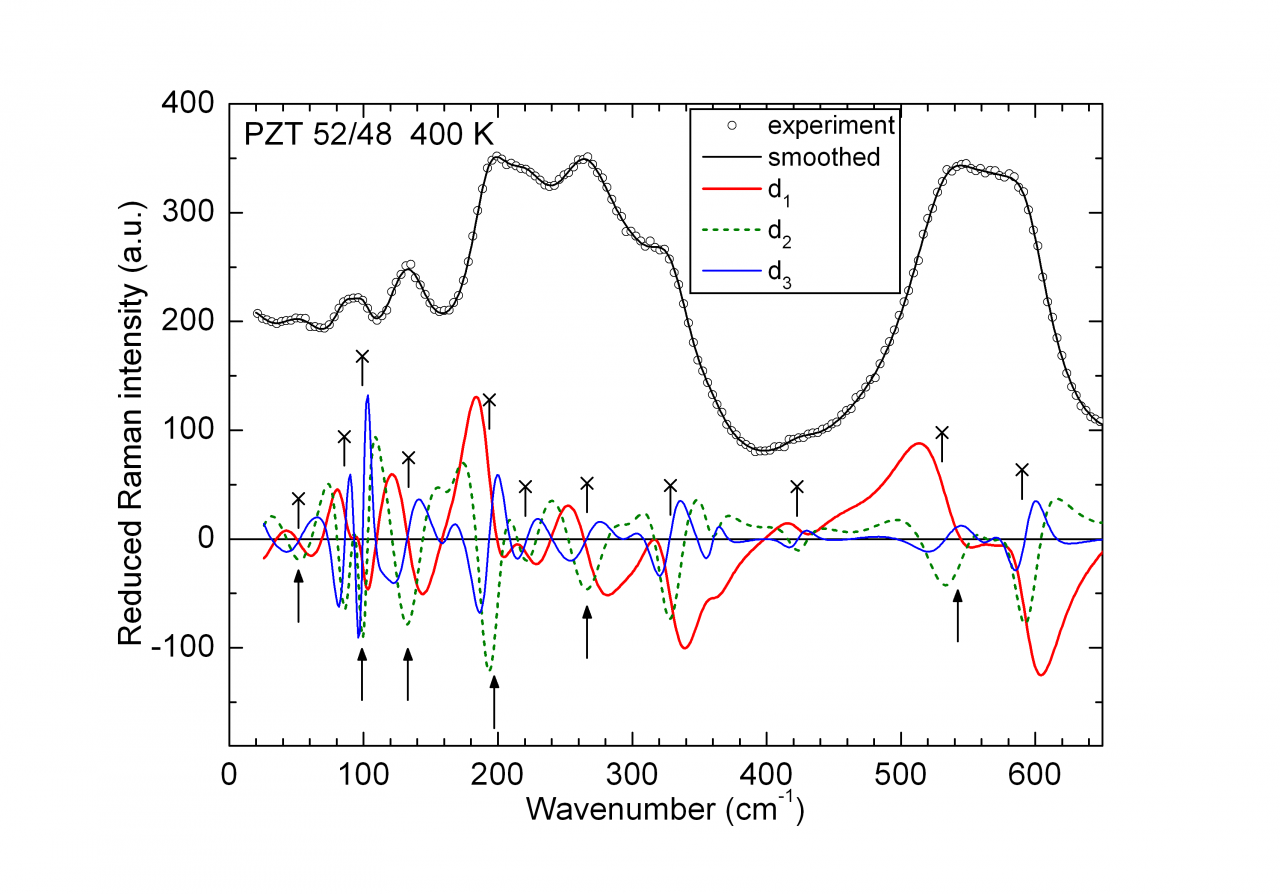
Figure 1: CMCD analysis of the Raman spectrum of the PZT 52/48 ceramics at 400 K together with the simulated smoothed spectrum and its derivatives up to the third order. Arrows denote frequencies of the maxima and the cross-symbols denote CMCD points, defined as negative minima of the second derivative of the spectrum..
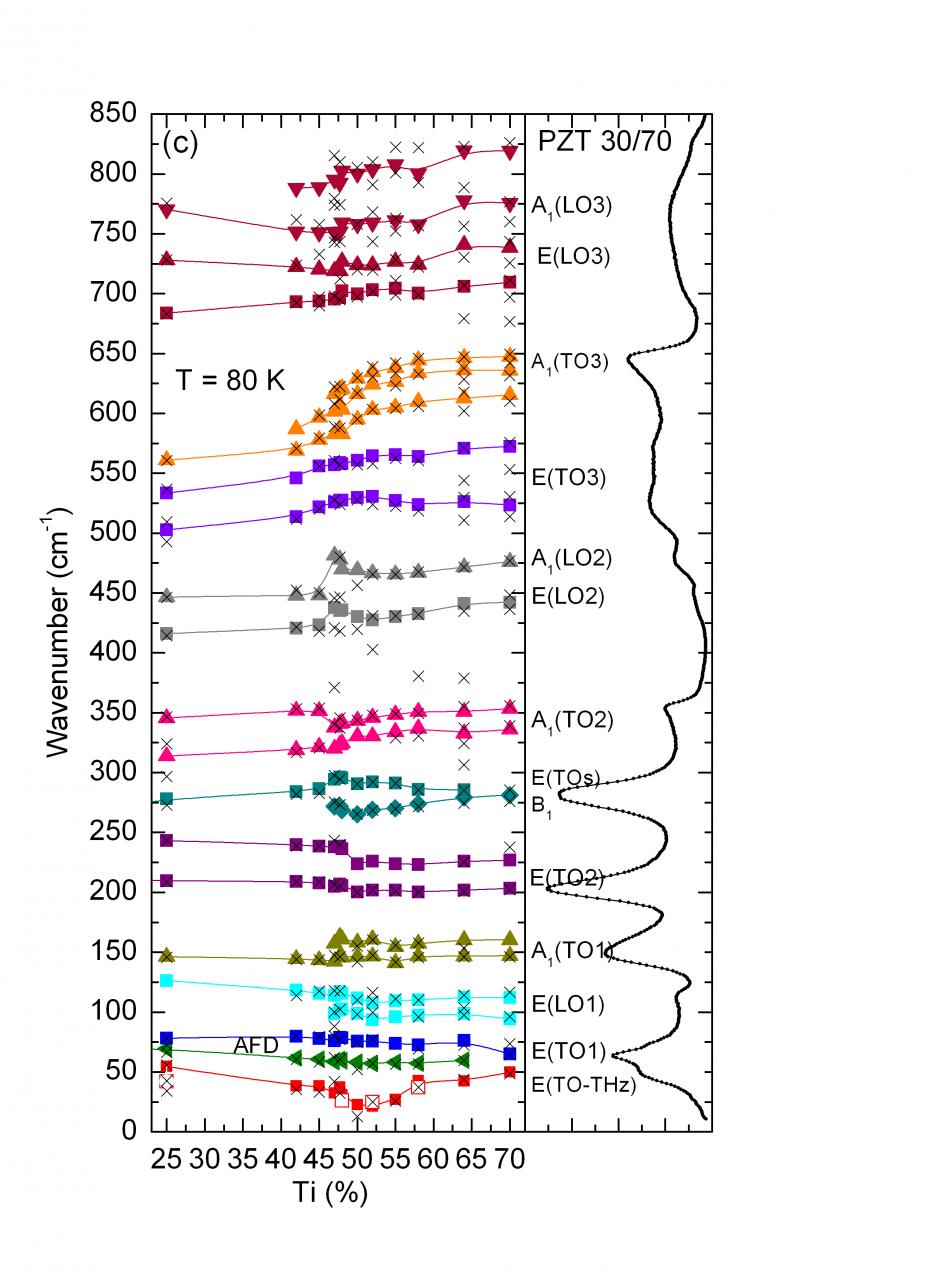
Figure 2: Compositional dependence of the phonon frequencies in PZT ceramics at 80 K. Black crosses correspond to the negative minima of the second derivative (peaks and shoulders). Spectra of the tetragonal sample 30/70 with labels are shown for illustration.
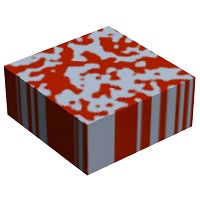
Polar fluctuations of nanoscale size as a source of giant dielectric response of relaxor ferroelectrics
Characteristic frequencies of nanoscale polar fluctuations have been resolved by means of neutron diffuse scattering measurements on a Sr0.61Ba0.39Nb2O6 single crystal in the MHz-GHz frequency region.
Comparison with dielectric measurements proved that these polar fluctuations are a source of giant dielectric response, whose temperature-frequency dependence is specific for a significant group of substances exhibiting a glass-type ferroelectric phase transition, so-called relaxor ferroelectrics [ P. Ondrejkovic et al., Phys. Rev. Lett. 113, 167601 (2014)].
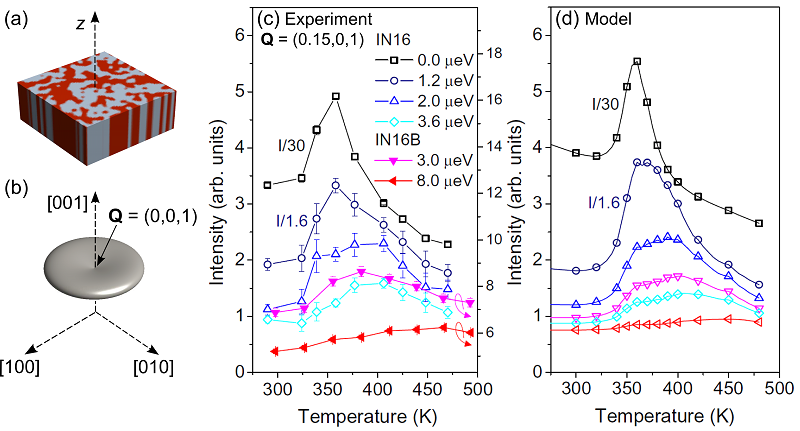
Figure: (a) Typical domain structure with polar nanodomains and (b) its characteristic disk-like diffuse scattering. Comparison of temperature dependence of diffuse scattering intensity obtained (c) experimentally on neutron spectrometers at Institut Laue-Langevin (Grenoble) and (d) numerically from a model based on dielectric data at various energy transfers.
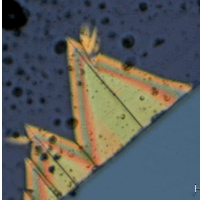
Catching intermediate phases in antiferroelectric single crystals
Ferroelectric and antiferroelectric single crystals show phase transitions that can be evidence by different experimental methods. In this work we investigated single crystals of antiferroelectric PbZrO3 substituted with 1% of Ti (PZT 99/1) by means of optical microscopy, micro-Raman scattering, second harmonic generation and dielectric spectroscopy, on heating to and cooling from its cubic phase.
Our measurements confirmed that these crystals undergo two phase transitions within the approximate temperature range 488–503 K. Second harmonic generation showed a marked signal between the two anomalies, implying that the intermediate phase is non-centrosymmetric. In situ Raman spectroscopy and the presence of second harmonic signal, excluded the antiferroelectric state of this phase. The intermediate phase of PZT 99/1 crystal is similar to the rhombohedral ferroelectric one with the R3m space group [ E. Buixaderas et al., Phase Transitions 87, 1105 (2014) ].
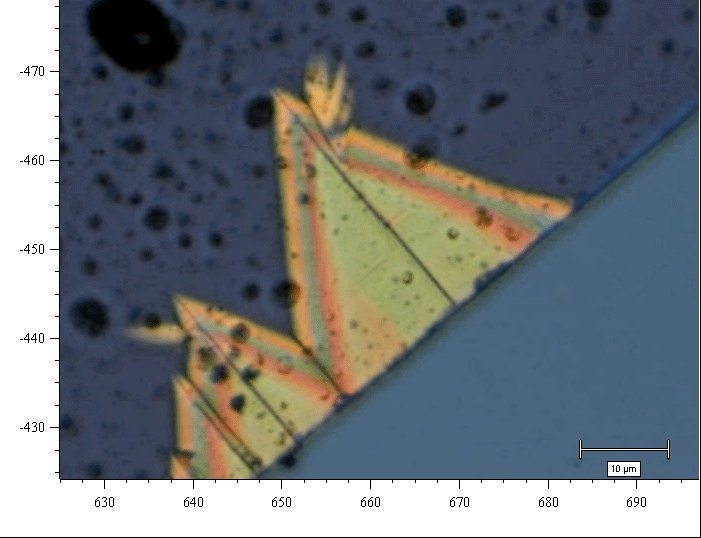
Figure 1: Micrograph of the PZT 99/1 crystal showing the growth of the intermediate ferroelectric phase within the cubic one, near 503 K, taken on cooling.
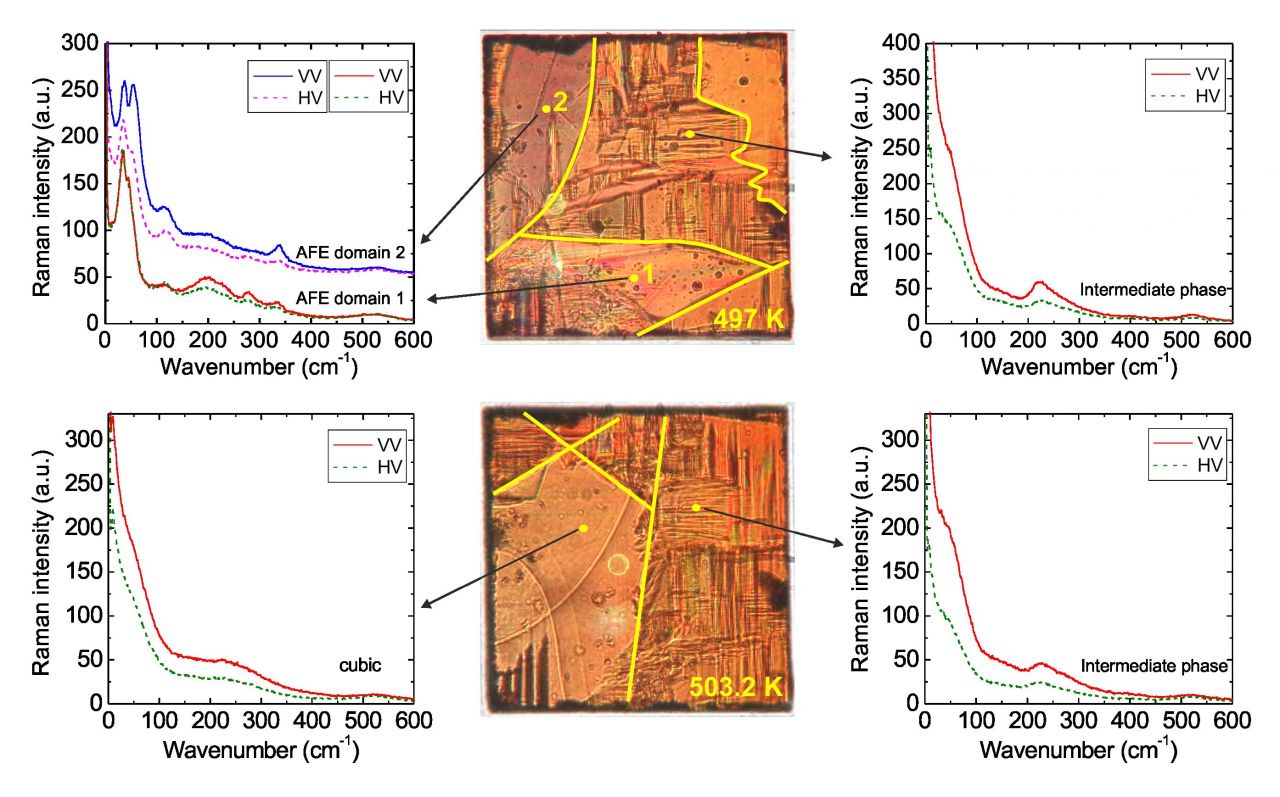
Figure 2: Raman spectra and HD optical micrographs taken at 497 and 503.2 K. Raman spectra recorded in different regions of the PZT 99/1 crystal are pointed by arrows. Left panels show Raman spectra of AFE and cubic phases, respectively; right panels show Raman spectra of the intermediate phase at these two temperatures.
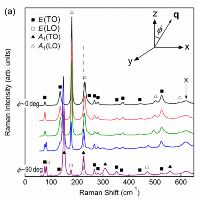
New experimental method allowed to record dispersion curves of polar lattice modes in magnetoelectric BiFeO3
Bismuth ferrite (BiFeO3) is a prototypical multiferroic system exhibiting extraordinary properties; it is ferroelectric up to TC ~ 1100 K as well as antiferromagnetic up to TN ~ 640 K. Characterisation of polar phonon modes is essential for understanding its dielectric and electromechanical behaviour.
Assigning the BiFeO3 polar modes probed detected in Raman spectroscopy is not straightforward due to the presence of so-called oblique phonon modes that do not match any pure TO or LO mode frequencies; instead, their frequencies continuously vary with the orientation of the phonon propagation vector. Using a monocrystal, mode assignment can be obtained by analysing a set of Raman spectra taken for different values of the angle between the phonon propagation vector and the optical axis (angular dispersion). To achieve the goal in absence of a de-twinned single crystal sample, we have developed an original technique in collaboration of the Institute of Physics AS CR and The University of Sheffild which enabled for the first time assigning these strongly anisotropic crystal properties using a polycrystalline material. We have taken advantage of the efficiency and spatial resolution of up-to-date micro-Raman spectrometers to collect a large enough set of spectra acquired on different randomly oriented grains of coarse-grain bulk ceramics. The pure TO and LO frequencies needed for angular dispersion determination were obtained from limit values of the phonon frequencies within the whole set of data. For each grain, the angle between the phonon propagation vector and optical axis was than determined from measured frequency of a chosen oblique mode. The obtained angular dispersion of the phonon mode parameters served as a basis of a full mode assignment [ J. Hlinka et al., Phys. Rev. B 83, 020101 (2011)].
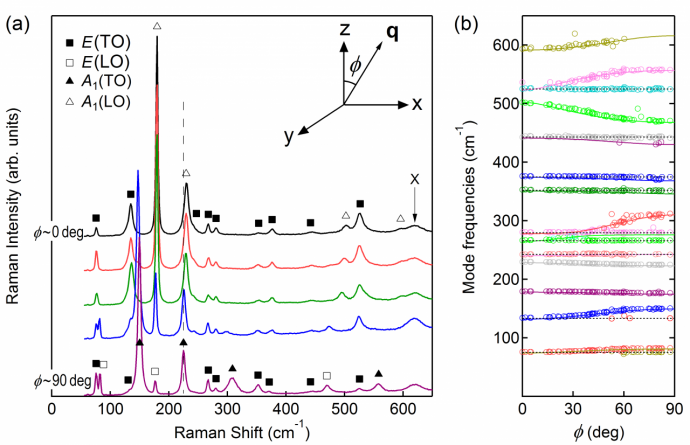
Figure: Phonon spectra of multiferroic BiFeO3. (a) Raman spectra from selected ceramic grains. Point symbols indicate positions of the pure modes. (b) Angular phonon dispersion curves. Full lines represent the oblique modes, dashed lines the purely transverse E(TO) branches, open circles are frequencies determined from individual Raman spectra as a function of the angle between the phonon propagation vector and the optical axis.

